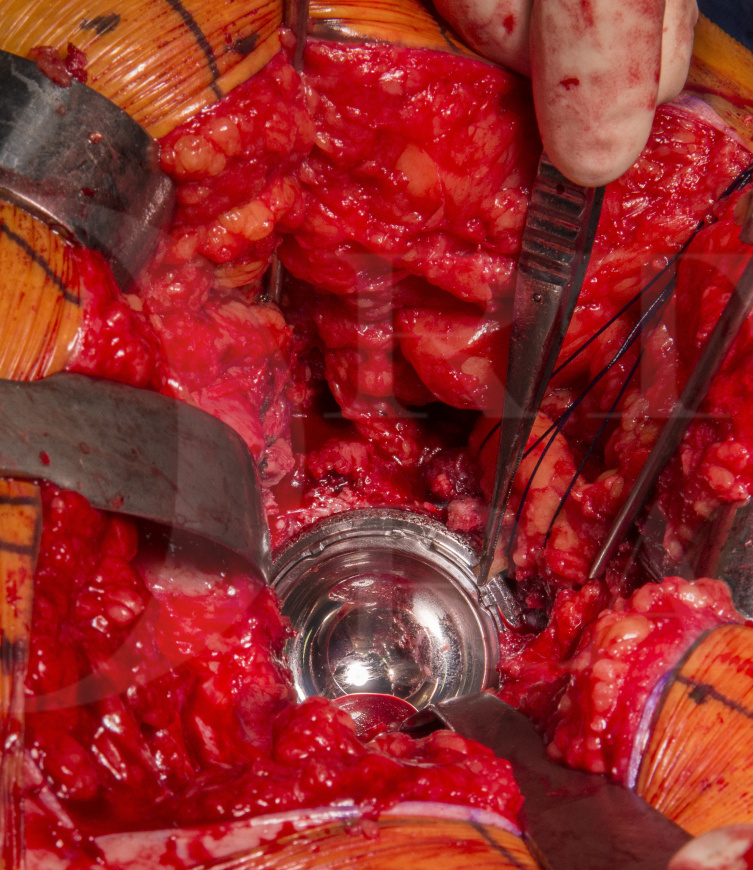Total Hip Replacement(posterior approach): Dual Mobility (MDMX3 head) and Exeter stem (Stryker)
Overview

Subscribe to get full access to this operation and the extensive Hip Surgery Atlas.
Learn the Total Hip Replacement(posterior approach): Dual Mobility (MDMX3 head) and Exeter stem (Stryker) surgical technique with step by step instructions on OrthOracle. Our e-learning platform contains high resolution images and a certified CME of the Total Hip Replacement(posterior approach): Dual Mobility (MDMX3 head) and Exeter stem (Stryker) surgical procedure.
This OrthOracle technique demonstrates the important and relevant steps when completing a cemented Exeter stem, uncemented acetabular shell and the MDMX3 dual mobility cup. A posterior approach to the hip is demonstrated.
The Exeter stem does not really need much of an overview as it has a long and distinguished career. It is an ODEP 13* rated implant. ODEP (Orthopaedic Data Evaluation Panel) is a benchmarking organisation which reviews outcomes of primary joints (hip, knee and shoulder). Outcomes are rated at time intervals (3, 5, 7,10 and 13 years) and given a grade (A*, A and B) depending on revision rate. The organisation and the ratings are explained on the ODEP website http://www.odep.org.uk/Home.aspx
The Exeter hip replacement has very low revision rates both in international hip registries and in published data (Carrington et al). Whilst not an indication to use it, it is also a very forgiving hip and minor varus or valgus malalignment does not appear to be associated with early revision, poorer functional hip scores or complications (Thomas et al).
A cemented stem can be used on any age patient but in the elderly it had a decreased incidence of the complications associated with uncemented implants in this age group, for example early migration and periprosthetic fracture.
The MDMX3 dual mobility hip is currently has a ODEP 3A rating. Most dual mobility implants have been on the market for a shorter length of time than standard implants. A dual mobility cup is used when the risk of dislocation is elevated, the head to neck ratio is increased compared to standard femoral heads and the jump distance can be greater. Potentially there is less impingement which can be beneficial in severely scarred, multiply operated patients with stiff hips.
The MDMX3 is a modular Dual Mobility Cup and is therefore useful to teams who already have the Trident or Tritanium acetabular cups in regular use. There is therefore no need to have a whole kit array to insert this (compared to a monoblock system). Advantages obviously, therefore, include less space required to store and stock a whole new system and training requirements are less. A potential disadvantage vs the monoblock systems is that there is, by default, another potential articulation which may be a source of wear particles or metal ions. To date, to my knowledge, this disadvantage has not been seen in clinical practice
Readers will also find the following associated OrthOracle techniques of interest:
Total Hip replacement: Cemented Exeter/Contemporary (Stryker) by a posterior approach
Total Hip replacement: Exeter femoral stem and Tritanium acetabular component (Stryker)
Exeter Trauma Stem for Intracapsular Neck of Femur Fracture – Stryker
Revision Total Hip replacement: Stryker custom acetabulum and SERF Dual mobility Hip (De Puy)
The Exeter Universal Cemented Femoral Component at 15 to 17 Years: An Update on the First 325 Hips.The Exeter Universal Cemented Femoral Component at 15 to 17 Years: An Update on the First 325 Hips. Carrington, Sierra, Gie, Hubble, Timperley, Howell. JBJS (Br) 2009;91:730-7
The Effect of Exeter Stem Malalignment on outcome and complication rates. Thomas, Simpson, Gill, Glyn-Jones, Beard and Murray 2018. Orthopaedic Proceedings. Vol 94
My thanks to Mr Richard Baker FRCS (Tr & Orth) who performed the procedure.
Author: Mr Andrew Gordon FRCS (Tr & Orth)
Institution: The Northern General hospital, Sheffield, UK.
Clinicians should seek clarification on whether any implant demonstrated is licensed for use in their own country.
In the USA contact: fda.gov
In the UK contact: gov.uk
In the EU contact: ema.europa.eu
Online learning is only available to subscribers.



















